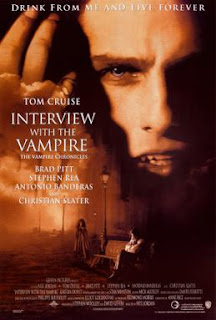So I jaunted over to Videodrome, the last video rental shop in Atlanta, and guess what movie was there?
The Plot
Kathy (Zoe Kazan) is a divorced alcoholic raising her ten-year-old daughter Lizzy (Ella Ballentine) and doing a pretty terrible job of it. She's on her way to her former husband's house for his turn at custody--a turn that's strongly implied to be permanent--but on an isolated road late at night, she hits a wolf, wrecking her car. And the wolf has already been injured fighting something else, which has left a big nasty tooth embedded in its body.
The two must wait for the tow-truck and ambulance to arrive, but there's something else waiting in the woods, something big and unpleasant and hungry...
The Good
*The acting in the film is phenomenal. Kazan does a great job portraying the terribly flawed Kathy, who knows she has a problem and isn't able to fix it. Ballentine does a good job with Lizzy, who has to be mature beyond her years and even act as the surrogate parent to her dysfunctional mother but still in some ways acts like a child. Their chemistry and acting skills are the best part of the film. In the DVD extras writer/director Bryan Bertino was concerned about how he could make a good movie where, most of the time, the two characters are stuck in one location (their car), but it works. It actually reminded me a lot of Cujo
*Per the above, the script does a good job illustrating how dysfunctional the situation is. In the first five or so minutes of the film we know something is very wrong--Kathy is absent and Lizzy is the one straightening up the house (including throwing away empty bottles of booze), fixing breakfast, etc. And although I'm generally not a fan of telling stories out of order, interspersing too many flashbacks, etc. Bertino makes it work.
*The movie rolls along at a nice quick pace and is particularly riveting in the latter half, when Kathy and Lizzy have to survive the rainy night alone against something that's very rarely seen but very dangerous.
*Although the poster for the film and the Blu-Ray/DVD covers undermine this by showing full-body and head-shots of the titular creature, the monster is handled classically by never showing too much of it. We first see it out of focus lurking behind Lizzy during one of her trips out of the car and we hear its cries, but we never see very much of it until the very end. That's a good thing because in one of the sequences at the end, parts of it look a bit...plasticky.
*Per the above, there's no bad CGI here. All practical effects--it's a man in a monster suit and it's a good monster suit.
*The way the creature sounds is very well-done. Although its precise nature is never explained, it has both reptilian and avian characteristics. It sounds like a combination of, say, a big alligator and a predatory bird.
*And although the trope of the Super-Persistent Predator is often mocked--most predators, particularly solitary ones that don't have kin to care for them if they're injured, aren't going to go after prey that's persistently able to harm or elude them--it makes sense for something that's living in the shadow of human civilization. Assuming the titular creature is intelligent--and it probably is, since it knows what cars are and how they work--it knows that it cannot permit any witnesses to survive lest it be hunted down and destroyed. The creatures from The Flock
*The setting makes a lot of sense. The road the women are stranded on is an isolated and near-abandoned one that's been bypassed by a newer road--that happens to have a lot of construction on it, forcing them to take the back way. The fact there's a wolf there along with...something else...makes sense. Animals will quickly move back into an area humans have left, especially if there's a big reserve of natural territory nearby.
The Bad
*There's a missed chance for suspense and drama early on when the friendly tow-truck driver Jesse (Aaron Douglas, who played Chief Tyrol in Battlestar Galactica
*The early parts, before the titular monster arrives, kind of drag a bit even though they're needed to establish the characters and establish audience feeling for them. I don't have any suggestions to change them without risking the bond the audience builds with them, so maybe it's best to leave them as they are.
*I didn't have a problem with this, but by trying to combine two genres, the movie might end up losing both. People who want family and addiction drama aren't going to be overly interested in a monster attacking people and people who are into monster movies aren't going to be into the family-drama stuff, even though it builds up the characters. Just FYI.
The Verdict
9.0 out of 10. This is the dysfunctional mother-daughter drama with a monster in it you didn't know you wanted to watch. Definitely check it out, at least for a rental.



